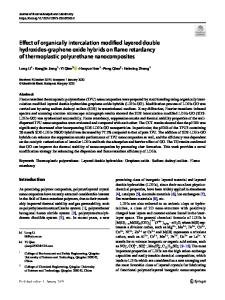Combustion behavior and thermal stability of TPU composites based on layered yttrium hydroxides and graphene oxide
- PDF / 3,442,182 Bytes
- 15 Pages / 595.276 x 790.866 pts Page_size
- 14 Downloads / 404 Views
Combustion behavior and thermal stability of TPU composites based on layered yttrium hydroxides and graphene oxide Yi Qian1 · Haoyue Han2 · Long Li2 · Peng Qiao1 · Rongmin Zhao3 · Haiming Zhang2 Received: 27 June 2019 / Accepted: 8 December 2019 © Akadémiai Kiadó, Budapest, Hungary 2020
Abstract Layered yttrium hydroxides (LYH)- and graphene oxide (GO)-supported layered yttrium hydroxides (GO–LYH) were synthesized by a co-precipitation route. The additives were characterized by X-ray diffraction and Fourier transform infrared spectra. The LYH were homogeneously dispersed on the GO sheets, demonstrated by the transmission electron microscope analysis. Composites of TPU/LYH and TPU/GO–LYH were prepared by a melt-blending method. The morphologies and structures of the composites, revealed by scanning electron microscope, ascertained that the dispersion of the GO–LYH in the TPU was better because of the strong interaction of the hydrogen bonds between oxygen-containing groups and hydroxyl groups. The fire retardancy of the TPU composites was evaluated using limiting oxygen index (LOI), cone calorimetry and thermogravimetric analysis. The TPU/LYH and TPU/GO–LYH composites, filled with 10 mass% LYH, 9 mass% GO, achieved LOI values of 24.4% and 25.3%, while there was a 67.42% and 70.88% decline of PHRR compared with pure TPU. The improved flame retardancy and smoke suppression were attributed to the physical barrier of GO and the catalytic carbonization of LYH indicated by char analysis. Keywords Layered structures · Nanocomposites · Flame retardancy · Thermal properties
Introduction Thermoplastic polyurethane (TPU) is widely used in automotive and mechanical parts, footwear manufacturing and cable sheathing due to its high wear resistance, high mechanical strength, wide mechanical range, oil resistance, water resistance, mold resistance and pliable processing feature [1]. This material certainly meets obstacles in the application areas. As an organic polymer, its flame-retardant performance is low with rapid combustion at high temperatures. More serious is the large amount of flame will be generated * Yi Qian [email protected] * Long Li [email protected] 1
College of Chemical Engineering, Qingdao University of Science and Technology, Qingdao 266042, China
2
College of Environment and Safety Engineering, Qingdao University of Science and Technology, Qingdao 266042, China
3
Qingdao University of Science and Technology Library, Qingdao 266042, China
when TPU is exposed to an external source of ignition. During the combustion process, enormous smoke and toxic gases will be released, endangering the safety of human life and property. Numerous studies have shown that additives can improve the properties of polymers [2–5]. Therefore, it is necessary to add flame retardant to the material for the sake of preventing or slowing down the ignition process [6, 7]. Currently, there are numerous studies on the flame retardancy of polymers with various organic and inorganic additives, including phosphorus, nitrogen, sil
Data Loading...











